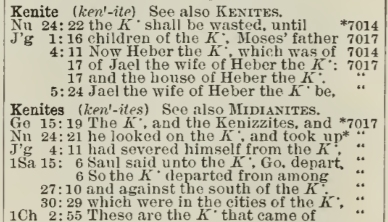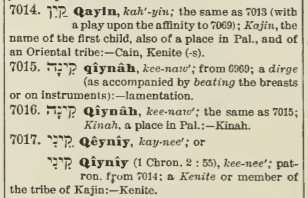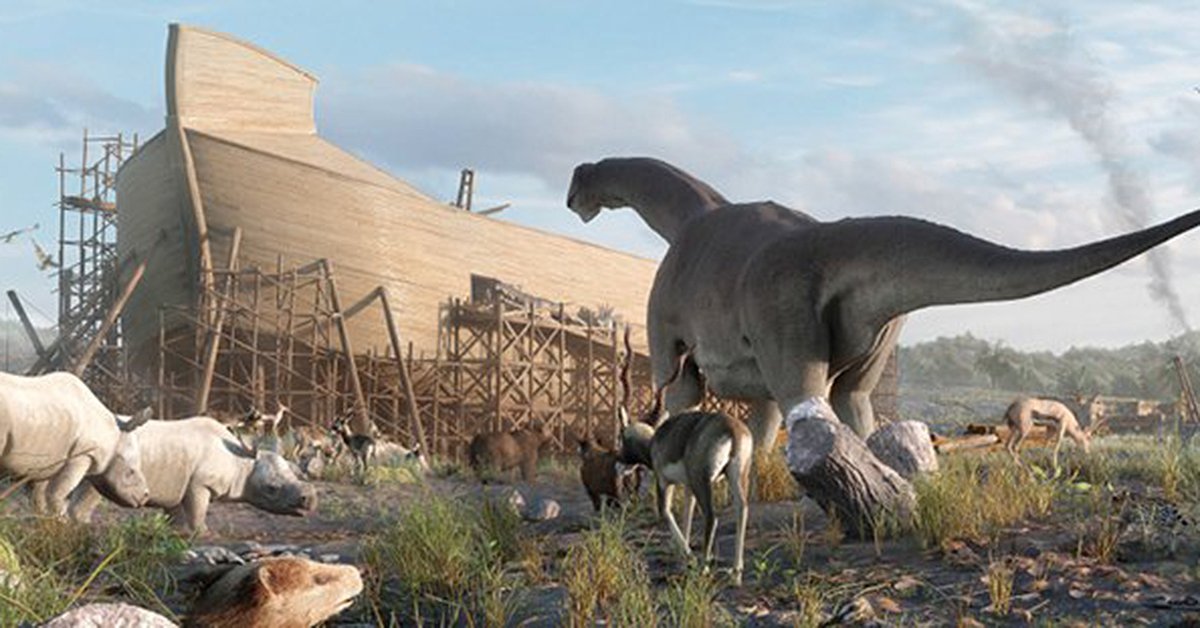KENITE (Heb. קֵינִי), a large group of nomadic clans engaged chiefly in metal working. The root
qyn has the same meaning in cognate Semitic languages, e.g., in Arabic
qayna, "tinsmith," "craftsman"; in Syriac and Aramaic
qyn'h, qyny, "metalsmith." In the Bible the word
kayin (
qayin) also means a weapon made of metal, probably a spear (
II Sam. 21:16); and the proper noun "Tubal-Cain, who forged all the implements of copper and iron" (
Gen. 4:22) is a compound name in which the second noun indicates the trade. There is a connection between this trade and the story of *Cain who wandered from place to place and was protected by a special sign: "Therefore, if anyone kills Cain, sevenfold vengeance shall be taken on him" (
Gen. 4:15). Among primitive tribes to the present day there are clans of coppersmiths and tinsmiths whom it is considered a grave offense to harm.
The Kenites came from the south: Midian, Edom, and the Arabah. Hobab ( *Jethro ), son of Reuel the Midianite, who aided the Israelites in the desert and served as their pathfinder (
Num. 10:29–32), was also known as the Kenite (
Judg. 1:16; 4:11). Enoch, son of Cain (
Gen. 4:17), is also mentioned among the Midianites (
Gen. 25:4;
I Chron. 1:33). Balaam's prophecy about the Kenites, "Though your abode be secure, and your nest be set among cliffs" (
Num. 24:21) appears to be a reference to the mountains of Midian and Edom (cf. Obad. 3–4), and Sela ("cliffs") designates perhaps the Edomite mountain-fortress Sela (today al-Saʿl near Baṣrah) around which rich copper deposits were located. The house of Rechab, which had preserved traditions of the time of the Exodus, was related to the Kenites (
I Chron. 2:55), and apparently also to Ir-Nahash and Ge-Harashim (
I Chron. 4:12–14), modern Khirbet Naḥās ("copper ruin," or "ruin of the copper city") in the Arabah, a copper mining center.
The Kenites were enumerated among the early peoples of Canaan, together with the Kenizzites and the Kadmonites (
Gen. 15:19). Relations between the Israelites and the Kenites were good, but B. Stade and others argued for Kenite influence on Moses and the religion of Israel. This "Kenite hypothesis" (updated by Halpern and by van der Toorn) holds that YHWH was not originally the God of the Hebrews and was not even known to the Hebrews. He was originally a Kenite tribal god who became known to Moses through his Kenite father-in-law, Jethro. Moses then made YHWH known to the Hebrews, who accepted Him as their God. As observed by van der Toorn, the Kenite hypothesis nicely accounts for the absence of Yahweh from earlier pantheons, Yahweh's link with Edom (
Deut. 33:2), the Kenite connection of Moses, and the Bible's positive attitude to Kenites. The major problem comes from the current scholarly view that the majority of Israelites originated in Canaan and did not trek through the desert encountering Kenites all the way as the Bible would have it. The historical role of Moses is likewise problematic. Nonetheless, the important role of the Kenites in early Israelite worship has been emphasized by the discovery of an Israelite sanctuary at *Arad . This explains the note of
Judges 1:16 about the Kenite family related to Moses (according to the Septuagint descendants, this venerated family served as priests in the sanctuary). They entered the region from the "city of palm trees," which cannot here indicate Jericho, but more likely refers to Zoar or Tamar in the northern part of the Arabah. Also, Heber, the Kenite husband or clan of Jael, who was at the time of the Deborah battle in northern Ereẓ Israel near Mount Tabor belonged to the Hobab family (
Judg. 4:11). It is hardly incidental that they pitched their tent at the oak (Heb.
eʾ
lon) in Zaanaim or Zaananim, evidently a holy tree. Their connection with early Yahwistic worship does not exclude the assumption that for a good part they made their livelihood as metal craftsmen (
Judg. 5:26).
Other Kenite families evidently occupied the region in the south, centering around Arad. This is the Negev of the Kenites and the cities of the Kenites referred to in the stories from the time of David (
I Sam. 27:10; 30:29). These settlements apparently included Kinah near Arad (
Josh. 15:22), and possibly Kain on the border of the wilderness of Judah (15:57). In the same region were also found the Amalekites, who wandered in Edom, Sinai, and the Negev, and among whom the Kenites lived. According to the Septuagint,
Judges 1:16 should read "and dwelt among the Amalekites" (MT, "among the people (ʿ
am)"). In view of the kindness the Kenites had shown to Israel during the Exodus (
I Sam. 15:6), Saul gave them friendly warning before attacking the Amalekites.





